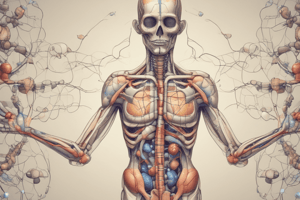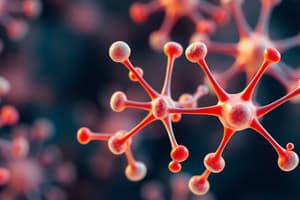Podcast
Questions and Answers
What is one of the main actions of opioid agonists on μ (MOP) receptors?
What is one of the main actions of opioid agonists on μ (MOP) receptors?
- Enhances glutamate transmission
- Increases serotonin release
- Inhibits the activity of adenylyl cyclase (correct)
- Promotes calcium ion influx
Which event occurs as a result of K+ channel opening in postsynaptic neurons?
Which event occurs as a result of K+ channel opening in postsynaptic neurons?
- Hyperpolarization of the neuron (correct)
- Inhibition of G protein activation
- Enhanced neurotransmitter release
- Increased positive charge inside the neuron
What is the effect of opioids on neurotransmitter release in relation to glutamate?
What is the effect of opioids on neurotransmitter release in relation to glutamate?
- Increases glutamate release from presynaptic neurons
- Has no effect on glutamate release
- Reduces glutamate release from presynaptic neurons (correct)
- Stimulates excessive glutamate release
Which endogenous substances act on opioid receptors within the body?
Which endogenous substances act on opioid receptors within the body?
Which pharmacological effect of opioids is characterized by a strong feeling of well-being?
Which pharmacological effect of opioids is characterized by a strong feeling of well-being?
Which category of opium includes heroin and oxycodone?
Which category of opium includes heroin and oxycodone?
What is the prototype mixed agonist-antagonist in opioid pharmacology?
What is the prototype mixed agonist-antagonist in opioid pharmacology?
Which opioid receptor is primarily associated with the action of analgesia and positive reinforcement?
Which opioid receptor is primarily associated with the action of analgesia and positive reinforcement?
Which opioid receptor is known for its involvement in respiratory depression and cardiovascular effects?
Which opioid receptor is known for its involvement in respiratory depression and cardiovascular effects?
What effect does naloxone have when administered to an opioid-dependent individual?
What effect does naloxone have when administered to an opioid-dependent individual?
What is a primary mechanism through which opioids produce euphoric effects?
What is a primary mechanism through which opioids produce euphoric effects?
Which of the following accurately describes the effects of opioids on respiration?
Which of the following accurately describes the effects of opioids on respiration?
What secondary effect is characteristic of opioid ingestion?
What secondary effect is characteristic of opioid ingestion?
What is a common consequence of chronic opioid treatment on the gastrointestinal system?
What is a common consequence of chronic opioid treatment on the gastrointestinal system?
How do opioids influence hormonal balance in men and women?
How do opioids influence hormonal balance in men and women?
What is the main characteristic of acute pain?
What is the main characteristic of acute pain?
Which type of pain is associated with increased sensitivity to painful stimuli?
Which type of pain is associated with increased sensitivity to painful stimuli?
What is a common side effect associated with the use of naltrexone?
What is a common side effect associated with the use of naltrexone?
Where are the cell bodies of primary afferent nociceptive sensory neurons located?
Where are the cell bodies of primary afferent nociceptive sensory neurons located?
Which class of medications can reduce firing of primary afferent neurons at the injury site?
Which class of medications can reduce firing of primary afferent neurons at the injury site?
What is the primary use of naloxone in medical settings?
What is the primary use of naloxone in medical settings?
Which statement accurately describes naltrexone?
Which statement accurately describes naltrexone?
Which neurological activity is involved in pain signaling between the brain and the spinal cord?
Which neurological activity is involved in pain signaling between the brain and the spinal cord?
How is naloxone primarily administered?
How is naloxone primarily administered?
What kind of pain is caused by noxious stimuli and does not involve conscious awareness?
What kind of pain is caused by noxious stimuli and does not involve conscious awareness?
What is one role of antidepressants in pain management?
What is one role of antidepressants in pain management?
What results from physical dependence on opioids?
What results from physical dependence on opioids?
What is the estimated single daily oral dose of naltrexone for treating heroin dependence?
What is the estimated single daily oral dose of naltrexone for treating heroin dependence?
Which of the following is true regarding morphine?
Which of the following is true regarding morphine?
What type of pain lasts for more than three months?
What type of pain lasts for more than three months?
How is codeine primarily metabolized in the body?
How is codeine primarily metabolized in the body?
What can occur due to maternal opioid use during pregnancy?
What can occur due to maternal opioid use during pregnancy?
What distinguishes heroin from morphine?
What distinguishes heroin from morphine?
What is a primary characteristic of Fentanyl as an opioid?
What is a primary characteristic of Fentanyl as an opioid?
Which opioid is known for having a ceiling effect limiting its analgesic effectiveness?
Which opioid is known for having a ceiling effect limiting its analgesic effectiveness?
What distinguishes Meperidine from Morphine in terms of side effects?
What distinguishes Meperidine from Morphine in terms of side effects?
What is one of the uses of Methadone?
What is one of the uses of Methadone?
What is the potent potency comparison of Propoxyphene?
What is the potent potency comparison of Propoxyphene?
Which of the following actions does Tramadol achieve?
Which of the following actions does Tramadol achieve?
Why is Morphine associated with a high risk when smoked with crack cocaine?
Why is Morphine associated with a high risk when smoked with crack cocaine?
In opioid rehabilitation, what is a significant advantage of using Buprenorphine?
In opioid rehabilitation, what is a significant advantage of using Buprenorphine?
Flashcards
Opioid Agonist
Opioid Agonist
A drug that binds to and activates opioid receptors, producing effects like analgesia and euphoria.
Opioid Antagonist
Opioid Antagonist
A drug that binds to opioid receptors but does not activate them, blocking the effects of opioids.
$\mu$ Receptor
$\mu$ Receptor
The primary opioid receptor responsible for analgesia, respiratory depression, and addiction.
Partial Agonist
Partial Agonist
Signup and view all the flashcards
Mixed Agonist/Antagonist
Mixed Agonist/Antagonist
Signup and view all the flashcards
Pain: Definition
Pain: Definition
Signup and view all the flashcards
Acute Pain
Acute Pain
Signup and view all the flashcards
Chronic Pain
Chronic Pain
Signup and view all the flashcards
Nociceptive Pain
Nociceptive Pain
Signup and view all the flashcards
Neuropathic Pain
Neuropathic Pain
Signup and view all the flashcards
Pain Signaling: Sensory Neurons
Pain Signaling: Sensory Neurons
Signup and view all the flashcards
Pain Signaling: Pathways
Pain Signaling: Pathways
Signup and view all the flashcards
Descending Pathways: Pain Inhibition
Descending Pathways: Pain Inhibition
Signup and view all the flashcards
Opioid Agonist Action
Opioid Agonist Action
Signup and view all the flashcards
Opioid Hyperpolarization
Opioid Hyperpolarization
Signup and view all the flashcards
Opioid Presynaptic Effect
Opioid Presynaptic Effect
Signup and view all the flashcards
Endogenous Opioids
Endogenous Opioids
Signup and view all the flashcards
Opioid Reward Pathway
Opioid Reward Pathway
Signup and view all the flashcards
Opioid Euphoria
Opioid Euphoria
Signup and view all the flashcards
Opioid Overdose Risk
Opioid Overdose Risk
Signup and view all the flashcards
Opioid-Induced Constipation
Opioid-Induced Constipation
Signup and view all the flashcards
Opioid Tolerance
Opioid Tolerance
Signup and view all the flashcards
Pupillary Constriction (Miosis)
Pupillary Constriction (Miosis)
Signup and view all the flashcards
Opioid Cross-Tolerance
Opioid Cross-Tolerance
Signup and view all the flashcards
Opioid Dependence Withdrawal Symptoms
Opioid Dependence Withdrawal Symptoms
Signup and view all the flashcards
Morphine Administration Routes
Morphine Administration Routes
Signup and view all the flashcards
Codeine Effects
Codeine Effects
Signup and view all the flashcards
Heroin Potency
Heroin Potency
Signup and view all the flashcards
Naloxone
Naloxone
Signup and view all the flashcards
Naltrexone
Naltrexone
Signup and view all the flashcards
Naltrexone: Side Effects
Naltrexone: Side Effects
Signup and view all the flashcards
Naloxone: Duration of Action
Naloxone: Duration of Action
Signup and view all the flashcards
Naltrexone: Long-term Treatment
Naltrexone: Long-term Treatment
Signup and view all the flashcards
Morphine's Advantage
Morphine's Advantage
Signup and view all the flashcards
Propoxyphene vs. Codeine
Propoxyphene vs. Codeine
Signup and view all the flashcards
Meperidine's Difference
Meperidine's Difference
Signup and view all the flashcards
Fentanyl's Delivery Methods
Fentanyl's Delivery Methods
Signup and view all the flashcards
Tramadol's Unique Action
Tramadol's Unique Action
Signup and view all the flashcards
Methadone's Dual Role
Methadone's Dual Role
Signup and view all the flashcards
Buprenorphine's Ceiling Effect
Buprenorphine's Ceiling Effect
Signup and view all the flashcards
Buprenorphine's Binding Power
Buprenorphine's Binding Power
Signup and view all the flashcards




